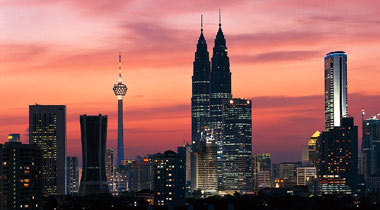
Transportation and Communications
Malaysia has a good transportation
network, but rapid economic growth has stretched it to the limit. Historically,
waterways were Malaysia's primary means of transportation. Even today, water
travel remains important because the country's mountainous terrain and thick
forests hinder movement by land. Rivers form the main thoroughfare into the
interior. River transport continues to play a major role in East Malaysia. The
Strait of Malacca, on the western side of the Malay Peninsula, serves as a major
shipping lane between Europe and Asia. The South China Sea links the two parts
of Malaysia and is the principal thoroughfare between East Asia and Southeast
Asia. Malaysia's major seaports include George Town, Port Kelang, and Johor
Baharu.Long-distance travel in Malaysia depends heavily on aviation. Kuala
Lumpur International Airport at Sepang is about 30 miles (50 kilometers) south
of Kuala Lumpur. This airport opened in 1998 and helped relieve congestion at
the older Subang airport. A government-owned airline called Malaysia Airlines is
the major Malaysian air carrier. In 1994, a second national airline called Air
Asia began operations. Kuala Lumpur is served by many international carriers,
including Malaysia Airlines, a state-controlled line. There are five regional
airports and numerous smaller airports located in Peninsular and East Malaysia.
Since Malaysia's economic boom began in the 1970's, the country's roads have
become severely congested. More Malaysians have bought motorcycles and
automobiles, adding to traffic congestion. Most middle-class families own cars,
especially Malaysian-built Protons. Lower-income groups tend to ride motorcycles
or use public transportation. Malaysia has an estimated 58,500 miles (94,000
kilometers) of roads, three-fourths of which are paved. Peninsular Malaysia has
several highways, but Sabah and Sarawak have poor-quality roads. The rail
network is well developed in Peninsular Malaysia, but Sarawak has no railway,
and Sabah has only a short line for freight and passenger traffic. Buses provide
most of Malaysia's public transportation. Railroads, which are owned by the
government, operate in Peninsular Malaysia and in Sabah.

A government-run corporation called Radio
Television Malaysia operates radio and television stations. Malaysia also has
commercial and cable television stations. Under the Broadcasting Act of 1987,
the federal minister of information has the power to monitor all radio and
television programming. The nation's press is privately owned but restricted by
laws that forbid the publishing of any matter considered harmful to the
country's security, order, or morality. The broadcast media are
government owned.Most Malaysian families have a radio or a television set, and
most also have a telephone. Cellular telephones are popular among business
people and the middle class, and the use of such phones has become a status
symbol in modern Malaysia.Malaysia has about 40 daily newspapers. The most
important papers include Berita Harian and Utusan Malaysia in Bahasa Malaysia
and the New Straits Times and The Star in English.